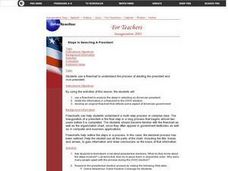Curated OER
What About Films?
High schoolers watch and analyze a film of an Appalachian folktale. They define trickster and anti-hero, view and discuss the film, complete a handout, compose an original film review, and debate each character's behavior.
Curated OER
Teaching Lewis and Clark: Why Fort Clatsop?
Students study the path Lewis and Clark took on their famous trans-American journey. They participate in an online activity that allows them to examine considerations the Expedition made when deciding where to spend the winter of 1805-06.
Curated OER
Jurassic Park Debate
Students research behavior, phsyiology, and ecology of dinoaurs. Students role-play as scientific specialists such as geneticists and ecologists. They present their research findings in a research paper.
Curated OER
THE FEDERAL CONFIRMATION PROCESS: CHOOSING THE RIGHT PERSON FOR THE JOB
Students analyze the process whereby presidential appointees are confirmed.
Curated OER
Steps In Selecting A President
Learners follow a flowchart that describes the process of electing the American president and vice-president. They create a flowchart that explains some aspect of the US government.
Curated OER
Paleontologist: Can You Dig It?
Students investigate what a paleontologist does. They participate in a dinosaur dig, write a story, and explore the Dinosaur Dig website to view and discuss photos of a real dinosaur dig.
Curated OER
"Let Me Sing A Carefree Song Once More:" Poetry of Hidden Children
Students read various poems dealing with hidden children during the Holocaust. Using the texts, they discuss the poems meaning with their classmates. They present their information to the class taking turns on who is speaking. They...
Curated OER
Telling Stories Through Creative Drama
Students examine fairy tales. As an introductory activity, students play the statue game. In groups, they write statements that tell the plot of the story. Using props, and without voices, students retell the story by creating...
Curated OER
Fact Or Fiction
Young scholars demonstrate their ability to distinguish between fact and fiction. Students identify the features of weather-related adages and proverbs. After reviewing several weather adages, young scholars explain whether they are...
Curated OER
Literature of the Islands and the Sea
Students read an age-appropriate novel in which an island setting plays an important role from a provided list. This will help them understand life on an island. They will analyze the plot, theme, characterization, setting, and style...
Curated OER
Family Responsibility and Commitment
Students are introduced to Picasso and how he created Baboon and Young, and interpret the expressive content of the work. They discuss and define what a family unit consists of, and form conclusions of their own. Students identify and...
Curated OER
Huw's Interview Tips
High schoolers identify, analyze and articulate correct strategies to interview other people. They choose open questions and learn how to make the most of an interview. In addition, they perform open interviews for the instructor and...
Curated OER
Colonialism in India / The Sepoy Revolt of 1857
Pupils examine the factors dividing colonial India. They examine the motives of the colonizers. They research colonial India. They participate in a debate on major controversies surrounding the revolt in colonial India.
Curated OER
Locating Vent Fields Using CTD Data
Students describe the way hydrothermal vents work. Students work on locating vent regions through remote collection of data about water temperature and density. Comparing density and temperatures graphs, students search for indicators...
Curated OER
And Justice for All?
High schoolers explore the history of the environmental justice movement. They examine how discrimination promotes environmental illness in low income communities. Students explain why minority and low income groups have less economic...
Curated OER
What things let Light Pass Through?
Second graders classify objects according to how well light can pass through them and predict how well objects will transmit light. They experiment with objects to verify predictions while collecting, recording, and interpreting data...
Curated OER
Hominoid Skull Comparison
Students are provided with evidence used to support evolutionary theory. They are introduced to classification by using primates as an example. Students read article related to Hominoid Skull Comparison and write a summary about the...
Curated OER
Electrophoretic Analysis: DNA Fingerprinting and Evolutionary Divergence
Young scholars examine the principles of electrophoresis. They evaluate both the agarose and polyacrylamide system of molecular separation. In order to bring the concepts of genetics and evolution full circle from DNA to protein,...
Curated OER
Looking At Science And Technology From a Human Rights Perspective
Young scholars answer discussion questions and analyze technological innovations, scientific discoveries, and environmental crises from a human rights perspective. They research and report back to the class about a related topic.
Curated OER
Halloween Comic Strips
Fourth graders participate in a lesson on the subject of creating comic strips. They create facial expressions in drawings for practice and gradually progress to making their own comic strips based on the holiday of Halloween. The...
Curated OER
Growing Voters and Election 2004: Classroom Debate
Young scholars research the issues and platforms of candidates and separate propaganda from process in order to choose a candidate to support. Students examine political parties and their contributions to shaping the foundation of the...
Curated OER
Prop Stories
Students observe and demonstrate pantomime and improvisation. They define and discuss improvisation and pantomime, then in small groups discuss and brainstorm ideas using a bag of props. Students then create and present a scene using...
Curated OER
Introducing Nepal Through Music
Pupils define traditional music, describe distinguishing characteristics of traditional songs, and discover the connection between music and cultural heritage in this Music and Social Studies lesson for the fourth through tenth grades.
Curated OER
Contributions of Ancient Egypt
Second graders identify the major contributions of ancient Egypt, including architectural monuments, e.g. the pyramids and Sphinx. They study the function of the pyramids as tombs for the Pharaohs.

























